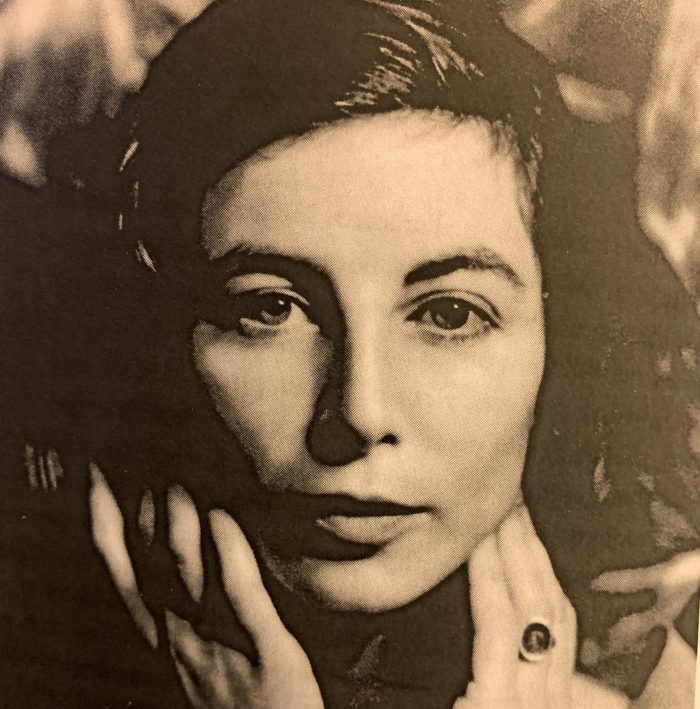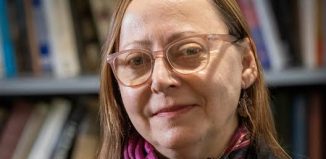Claire Nicolas White, Iconic Figure of the LI Arts Community
Claire Nicolas White, born June 18,1925, in Groet, Netherlands, died May 26 in St. James.
A woman of vast and varied talents, she was a poet, writer and teacher of ballet, French and writing. Daughter of stained-glass painter Joep Nicolas and sculptor Suzanne Nys, Claire spent her early childhood in the Netherlands and a convent school in France. When she was 14, her parents fled the Nazi menace. Her father had a commission to paint a mural in Rockefeller Center, New York, where the family felt at home in a European community of exiled artists and writers. Claire and her younger sister, Sylvia, attended the Lycée Français with the children and grandchildren of other refugees.
When she’d arrived in New York, Claire spoke Dutch and French. By the time she graduated from Smith College, she’d fallen in love with English. In the poem, “Marriage II,” she wrote:
But English I wed for better or worse,
my reality, my daily companion.
In 1946, Claire, with her mother, sister and fiancé, drove to California to visit her mother’s sister, Maria, and her husband, writer Aldous Huxley. In a 2017 interview, Claire said that her famous uncle had encouraged her to follow her chosen path.
After graduating from Smith College, she married Robert White, renowned sculptor and a grandson of the architect Stanford White. Speaking of the primacy of art in their relationship, Claire said, in that same interview, “Life is chaos; art is necessary to organize it.”
Claire and Bobby had four children. Their oldest, Sebastian, became a physicist; Stephanie, a dancer; and Christian, a painter. Claire’s youngest child, Natalie, died in a car accident when she was only 17. Claire also had six grandchildren and two great-grandchildren. Until her last days, her close family, including many nieces and nephews, was a continual source of joy. She took pride in the way Sylvia and her son, Diego, have carried on the stained-glass legacy of the Nicolas family.
Because of family connections and her schooling, Claire was accustomed to meeting famous people. She wrote opera libretti for Vittorio Rieti, the composer, a great friend and the father of the artist Fabio Rieti, her Lycée classmate. Cartier-Bresson photographed her as a young woman. She took silent walks with the Indian writer and philosopher, Krishnamurti, who taught her how to concentrate on each step. Through Rieti, she met Igor Stravinsky and introduced him to Aldous Huxley. Through Stravinsky, she met the great choreographer, George Balanchine. When Bobby won a Prix de Rome, the couple befriended the writer William Styron and his wife in Italy.
And yet Claire was not drawn to the limelight. She was fond of quoting the line in Emily Dickinson, “I’m Nobody! Who are you?” Putting down roots in St. James, she created an astonishing legacy, producing poems, libretti, plays, essays, memoirs, novels, art criticism (Art News, Newsday) and translations of Dutch and French literature. She mentored students of all ages at the Walt Whitman birthplace, in schools all over Long Island and in nursing homes. At Taproot Workshops & Journals, a nonprofit that encourages senior citizens to write in all genres, Claire was, according to its executive director, Enid Graf (in a letter to The New York Times,1995), “One of the organization’s finest teachers.” Claire was also the first editor of Oberon Poetry Magazine, founded in 2002 and still published by the Oberon Foundation.
She wrote into her 90s, both poetry and prose. Writer Orel Protopopescu, like many others in Claire’s orbit, considered her a mentor as well as a friend: “Until late last year, she was well enough to meet with our writing group weekly and would surprise us with unexpected turns of phrase, and a wry wit that was inimitably hers. Poems came to her with the regularity of dreams. There is a short poem called “The Tower” in which Claire describes an old wooden water tower close to her house. Its concluding lines encapsulate her philosophy of life:”
When life is flat I tower it
with a view
of the infinite.
In 2006, Claire donated her work to Stony Brook University Special Collections & Archives. Open to researchers without restriction, the collection comprises 10 cubic feet of newspaper clippings, articles, manuscripts, journals, notebooks, correspondence and published works from 1944 to 2006.
Reading the titles in this collection, not all listed below, made me dizzy. I had thought that I knew her, but now I see I only had a glimpse. Claire was an extraordinary woman, complex and not always easy. She had a powerful impact on the lives of all of us privileged to know her, work with her, live a part of our lives with her and to love her.
Some of Claire White’s publications:
Poetry in reviews and anthologies: The New Yorker, Partisan Review, Grand Street, Atlantic Monthly, Witness, Confrontation, The Paris Review, Long Island Quarterly, Paumanok, Poems and Pictures of Long Island and A Taste of Poetry (Walt Whitman Birthplace Association).
Translations: “The Time of Our Lives (Journal d’une petite fille)” by Martine Rouchaud, 1946 (with Louise Varèse); “The Assault” by Harry Mulisch, 1985 (Pantheon Books, 1985 Honorable mention, PEN Translation prize); “A Night in May (La Nuit de mai)” by Alfred de Musset, 1989; “A Letter of Time” by Hans van de Waarsenburg in 1989; “The Vanishing” by Tim Krabbé, 1993; and “My Father’s War: A Novel” by Adriaan van Dis, 1996.
Selected books, poetry and prose: “The Death of the Orange Trees” (Harper and Row, 1963), a novel; “Joep Nicolas, leven en werk” (life and work) (Van Spijk, 1979); “Biography and Other Poems” (Doubleday, 1981); “Fragments of Stained Glass” (Mercury House, 1981), a memoir (Spanish tr. “Mosaico de Una Vida,” Sabina Editorial, 2017); “The Bridge” (Cross Cultural Communications, 1987); “River Boy,” 1988 (ed.); “Stanford White: Letters to His Family” (Rizzoli,1997); “The Elephant and the Rose” (The Vineyard Press, 2003), a memoir’; and poetry collections: “Riding at Anchor” (Waterline Books, 1994); “News from Home” (Birnham Woods Graphics, 1998); and since 2004: “Elusive Harbors” (poetry), “An Armful of Time, Snapshots” (memoir), “Ernestine” (novella), “Robert White, Sculptor,” “The Land of the Smiths” (2014) and “Five Generations Painting with Light” (2019).
Submitted by Kathy Donnelly with contributions from poets and writers.







